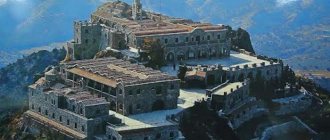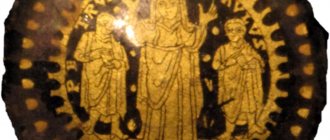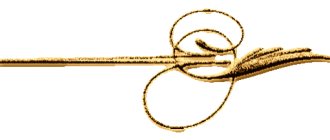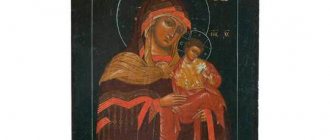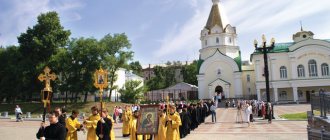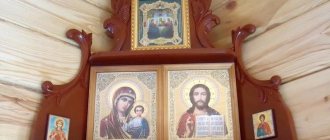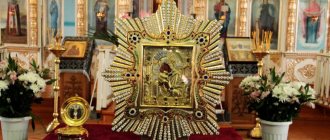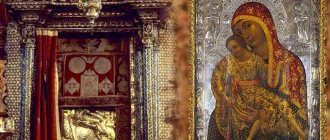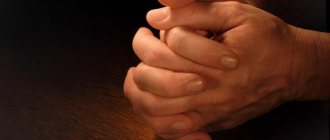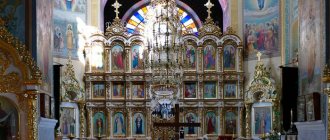The meaning of icons in Christianity
It is noteworthy that initially in the early church there were no icons in principle, but as time passed, people’s trust in everything spiritual began to decline. Christians needed a visible image on which to focus their attention when performing prayerful worship. Metaphorically, icons can be imagined as a magnifying glass, a huge number of rays of which become a giant scorching ray.
Find out what awaits you today - Horoscope for today for all zodiac signs
In the process of creating holy faces, icon painters try to convey to the viewer as strongly as possible the real emotions that the saints experienced in the depicted time. The holy image is filled with grace-filled power, which subsequently exerts its miraculous effect when believers pray in front of it.
Note! Christians worship not the picture, but the person depicted on the face. This principle is relevant in the Orthodox Catholic Eastern Church.
General information about this holy face
The face of the Virgin Mary, called “Rejoices in You,” is a very recognizable image of the Mother of God, the name of which is intended to remind all humanity of the support from the Mother of God. The time of appearance of this face is the fifteenth century, it was then that Orthodox Christians were first able to contemplate the mystical power of the icon.
The amazing icon of the Mother of God “Rejoices in You” is known in all corners of the globe. It has been established that the images of the Virgin Mary from this series begin to appear a couple of hundred years ago.
Their name is borrowed from the opening lines of the prayer service of the same name, authored by St. John of Damascus:
“He rejoices in You, O Blessed One...”
John of Damascus: historical background
The Monk John of Damascus was born at the end of the 7th century in Damascus (one of the cities of Syria). He went down in history as a hymnographer, philosopher and theologian. John served under the Damascus caliphate. He used all his influence for the benefit of the Christian faith. Throughout his life he wrote many dogmatic works. However, he became famous thanks to iconoclasm. The story of the appearance of the “Three-Handed” icon is connected with his name. John is the author of the work “The Source of Knowledge.” In addition, he wrote a number of hymns about the Mother of God, including “Rejoices in You.” The canons about the Nativity of Christ, Easter and Epiphany belong to his pen.
Photo 4. At the icon “Rejoices in You” it is customary to praise the Mother of God.
Leaving service for the good of the state, John moved to Palestine, where he took monastic vows in a temple near Jerusalem. There he served God until his death. It is known that his relics were transported to Constantinople. Now there are particles of them in the Monastery of Saint Sava, the Monastery of St. John the Theologian and the Monastery of St. George. John's Memorial Day is celebrated on December 17th.
Historical information about the face “Rejoices in You”
Due to numerous requests from readers, we have prepared an “Orthodox Calendar” application for smartphones. Every morning you will receive information about the current day: holidays, fasts, days of remembrance, prayers, parables. Download for free: Orthodox Calendar 2022 (available on Android)
The image in question is one of those few icons of the Mother of God, the purpose of which was not to receive the intercession of the Holy Virgin, but the desire to express our sincere gratitude to her for everything she has done to help a person.
Christians kneel before the icon, sing songs, giving thanks for all the good deeds that Saint Mary has done and continues to do today.
It is this face that allows us to fully demonstrate the full degree of gratitude and respect of the Orthodox people to the Mother of God for the fact that in any situation she readily comes to the rescue in difficult moments of life, acting as support and support to all individuals who need her.
Overview and characteristics of the icon
Now let's study the image of the face itself.
The background of the image is represented by the temple. And in front of the church we see the Most Holy Theotokos herself, sitting on the royal throne. The head of the Holy Virgin is covered with a crimson-red robe. With the help of her hands, the Mother of God holds little Jesus, who is placed on her feet.
Next to the royal throne is St. John, who wrote that very prayer, the first line of which gave the name to the image being described. At the foot of the throne we find the holy martyrs surrounding the Virgin Mary.
The face of the Virgin Mary is surrounded by an iridescent sphere that descended from heaven together with angelic beings. Everyone around the saint praises and glorifies her in every possible way.
The image “He rejoices in You” is very, very significant for representatives of Orthodox Christianity. Since it is of great importance not only to pray for help when you feel very bad, but also not to skimp on showing sincere gratitude to the Almighty and all the saints for this very help.
Description of the icon
At the first glance at the image of the Mother of God sitting on the throne with the Baby in her arms, the heart is filled with a special, difficult to convey, joy. There is no exact date and name of the artist who depicted on the canvas the grace-filled prayer “Rejoice for you!”
Having before your eyes a holy image and a prayer of the same name, you immediately find the embodiment of everything that is stated in it. John of Damascus in his song of thanksgiving said that in the Blessed Mother of God every creation, angels and people, has joy,
The artist managed to convey God’s covenant about the rainbow, depicting its image in the form of an angelic cathedral, a blooming paradise and temples surrounding the holy face of the Mother of God with the Child in a semicircle from above. This is a symbol of the entire New Earth, Jerusalem and the Garden of Eden.
Icon of the Mother of God “Rejoices in You” in the interior of the temple
The Most Pure Virgin, dressed in crimson clothes, tenderly hugs the Baby sitting in Her arms. In front of the Throne, bending on his knee, the author of the prayer “Rejoices in You”, John of Damascus, is depicted, holding a paper scroll in front of him; most likely, these are the prayers of believers, which are brought to the feet of the Mother of God and the Savior.
On the right side are the myrrh-bearing women. The holy martyrs are located in a semicircle at the foot of God's throne, around them are depicted images of ordinary people and kings, monks and patriarchs, all equal before the Almighty God.
Divine light emanates from the image of the Virgin and Child, giving joy to all who came with a prayer of gratitude. The holy face “Rejoices in You” is filled with grace-filled power transmitted through the artist’s devoted heart filled with God’s glory.
Important! The Mother of God is the source of Christian hope for Her protection and help. Through the Mother of God, our prayers are offered before the Savior, Jesus Christ, to whom we give all glory, honor, and worship forever and ever.
How can the miraculous image “Rejoices in You” help?
It was already said earlier that the main mission of the face “Rejoices in You” is not to support people in difficult times and not to heal them from illnesses. The image has a special characteristic, and its purpose is to express one’s sincere gratitude to the Mother of God.
Christians visit the temple and offer their gratitude to the great miraculous face. Thanks to these actions, they purify their soul and are filled with inner glow, harmony and virtue.
Of course, Saint Mary can observe how the faithful express their respect to her image. She hears sincere expressions of gratitude for help, and sees good actions from those who once sought support and intercession. It provides such individuals with even more powerful protection, contributes to the healing of their spiritual and physical wounds, as well as the easy and harmonious elimination of all difficulties and obstacles from their path in life.
That is why the image “He rejoices in you” has such great significance for Christians. Since, using this shrine, people will be able to express their gratitude to the Mother of God, thereby achieving her highest heavenly intercession.
For Christians, on the date of the celebration of the Council of the Blessed Virgin Mary, there is also a celebration when the holy icon “Rejoices in You” is venerated. This happens on the eighth of January (or the twenty-sixth of December according to the old style) - then believers turn to the image with words of gratitude, expressing their honor to it and glorifying the name of the Mother of God.
With the help of the Mother of God image discussed in this material, we realize the most important idea: remember the higher powers not only when you feel bad, you suffer and are subject to sadness and despondency, but also when your heart is filled with joy, happiness and love. Learn to thank God and all the saints with all your heart for the fact that you live and for everything that you have.
Story
The creation of the icon was based on the proclamation “She rejoices in You, O Blessed One.” The history of the events that led to the creation of the image is very unusual. Its reality is hard to believe. At the end of the 8th century, Emperor Leo III issued a strict decree prohibiting the worship of Christian faces. All icons and frescoes were ordered to be destroyed. John of Damascus, known for his Christian virtues, spoke out against such acts. He began sending letters to people about defending icon veneration. Not everyone liked his active position. Leo III was frankly hindered by his activities.
Photo 1. John of Damascus experienced the divine healing power of the Mother of God.
But the emperor could not openly kill a citizen of a foreign state, so he decided to act by cunning. On behalf of the icon painter, he wrote a forged document, which stated that the priest had allegedly prepared a plot to overthrow the caliph, and was inviting the emperor to speak in his support. The document was sent to the caliph's palace. The latter became very angry and ordered John to be punished. The caliph did not begin to understand the situation, although until that moment the ruler had no reason not to trust the icon painter. John Mansura was unfairly accused of treason. And then they cut off his hand as punishment.
The Archbishop of Damascus was saddened by the fate of John and did not leave his side after the execution. At his request, he brought the man his severed hand. John tore off the bandage and put his hand to the wound, wrapping everything with a towel. In a feverish state, the icon painter extended his hand to the icon of the Mother of God, asking her for healing. All night John screamed and prayed until he fell from pain and exhaustion. Half asleep, he felt eyes on him. Opening his eyes, the icon painter saw the light that poured from the holy image. The Most Pure Virgin looked at him. Then John heard a voice that told him that the Mother of God hears all the prayers coming from sincere believers. The Mother of God told the icon painter that she had healed his hand.
In a state of bliss, John took off the bloody towel. Then he saw a red scar on his hand at the junction of injured tissues. The icon painter tried to move his fingers and through the pain he felt that they were working. Happy John began to read a prayer of thanks. After the healing, the icon painter promised to paint icons and serve God. He kept his promise.
To conclude the topic:
- Icons are needed so that a person can focus his attention on a certain visible image when performing prayer.
- Prayers to the icon “He rejoices in you” are not aimed at asking for something, but at gratitude for what has already been received from higher powers.
- To see the most recognizable copy of the “Rejoices in You” icon, you should go to the Tretyakov Gallery (located in Moscow).
- It is important not only to ask higher powers for help in unhappy moments of life, but also to show your gratitude to them for their help.
And at the very end of the topic, finish reading by watching an interesting video:
How to pray
As we have already mentioned, the face “Rejoices in You” was given to people not for healing, but to support believers. The icon has a special meaning. It is intended to give people the opportunity to offer prayers of thanksgiving to the Mother of God.
Believers come to the temple not only to ask the Mother of God for a solution to some problems, but also to give her gratitude. Near the image, people can cleanse the soul, letting virtue and light into it.
Photo 5. The image bestows grace sent by the Virgin Mary.
You can pray not only at home, but also in church. The Virgin Mary sees Christians kneeling before her miraculous image and thanking her for her mercy. The Mother of God patronizes absolutely all people. The Mother of God protects believers even more strongly. But this does not mean that others are deprived of her support. Our Lady helps them heal physical and mental wounds and overcome all kinds of difficulties and obstacles. That is why the icon is so revered. Believers can kneel before it in any temple where it is available. It is not necessary to read the song “He rejoices in You.” Reading other prayers is also allowed. If you don’t know the text, you can thank the Mother of God in your own words. The confessors note that the Virgin Mary hears all appeals and prayers. The shrine helps to thank the Mother of God and win her attention. The patronage of a saint is very important for every believer.
People can also turn to the Mother of God with prayers of thanksgiving at their home icon.
